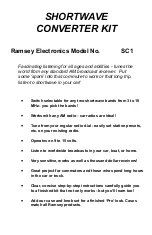
PAQ
-S48
PAQ
B-245
・All specifications are subject to change without notice.
(2)Mounting hole on PCB
Diameter of hole and land of PCB with referring below.
Type
Input Terminal Pin
Hole Diameter
Land Diameter
Output Terminal Pin
Hole Diameter
Land Diameter
Signal Terminal Pin
Hole Diameter
Land Diameter
PAQ-S48
φ 1.0mm
φ 1.5mm
φ 3.0mm
φ 1.5mm
φ 2.0mm
φ 4.0mm
φ 1.0mm
φ 1.5mm
φ 3.0mm
For position of the holes, see outline drawing of the power module.
(3) Recommended Material of PCB
Recommended materials of the printed circuit board is double
sided glass epoxy with through holes. (thickness: t=1.6mm)
(4)Output Pattern Width
When several to tens amperes of current flows to output pat-
tern, voltage would drop and heat generation would be higher
for narrow pattern. Relationship between current and pattern
width changes depending on material of printed circuit board,
thickness of conductor, temperature raise allowance. 35mm
copper glass epoxy printed circuit board is shown in Figure2-2
as an example.
For example, when 5A of current flows and temperature rise
below 10℃ are expected, pattern width shall be more than
4.2mm with 35µm copper plate (generally 1mm/A is standard).
Confirmation is definitely necessary for designing because
characteristics shown in figure 2-2 depends on manufactures
of printed circuit board.
14
12
10
8
6
4
2
0
1
2
3
4
5
Pattern width (
mm
)
60
℃
40
℃
20
℃
10
℃
C
ur
re
nt
(
A
)
Fig.2-2 Characteristic of current allowance
3 Recommended Soldering Method
Recommended soldering temperature is as follows.
(1) Soldering dip
260℃ within 6seconds
Pre-heat condition 110℃ 30-40seconds
(2) Soldering iron
350℃ within 3seconds
4 Recommended Cleaning Condition
Recommended cleaning condition after soldering is as follows.
● Cleaning solvent
IPA(isopropyl alcohol)
● Cleaning Procedure
Use brush and dry the solvent completely.
Note)For other cleaning methods, contact us.
Before concluding power module damage
Verify following items before concluding power module
damage.
1)No output voltage
● Is specified input voltage applied?
● Are the ON/OFF control terminal (CNT terminal),
remote sensing terminal (+S, -S), output voltage
trimming terminal (TRIM) correctly connected ?
● For cases where output voltage adjustment is used,
is the resistor or variable resistor setting, connec-
tions correctly done?
● Are there no abnormalities in the output load used?
● Is the beseplate temperature within the specified
temperature range?
2)Output voltage is high.
● Are the remote sensing terminals (+S, -S) correctly
connected?
● Is the measurement done at the sensing points?
● For cases where output voltage adjustment is used,
is the resistor or volume setting, connections cor-
rectly done?
3)Output voltage is low
● Is specified input voltage applied?
● Are the remote sensing terminals (+S, -S) correctly
connected?
● Is the measurement done at the sensing points?
● For cases where output voltage adjustment is used,
is the resistor or variable resistor setting, connec-
tions correctly done?
● Are there no abnormalities in the output load used?
4)Load regulation and line regulation is large
● Is specified input voltage applied?
● Are the input terminals and the output terminals firmly
connected?
● Is the measurement done at the sensing points?
● Is the input or output wire too thin?
5)Out put ripple voltage is large
● Is the measuring method used the same or equiva-
lent with the specified method in the Application
Notes?
● Is the input ripple voltage value within the specified
value?
Summary of Contents for PAQ50S48-1R2
Page 36: ...B 260...
















































